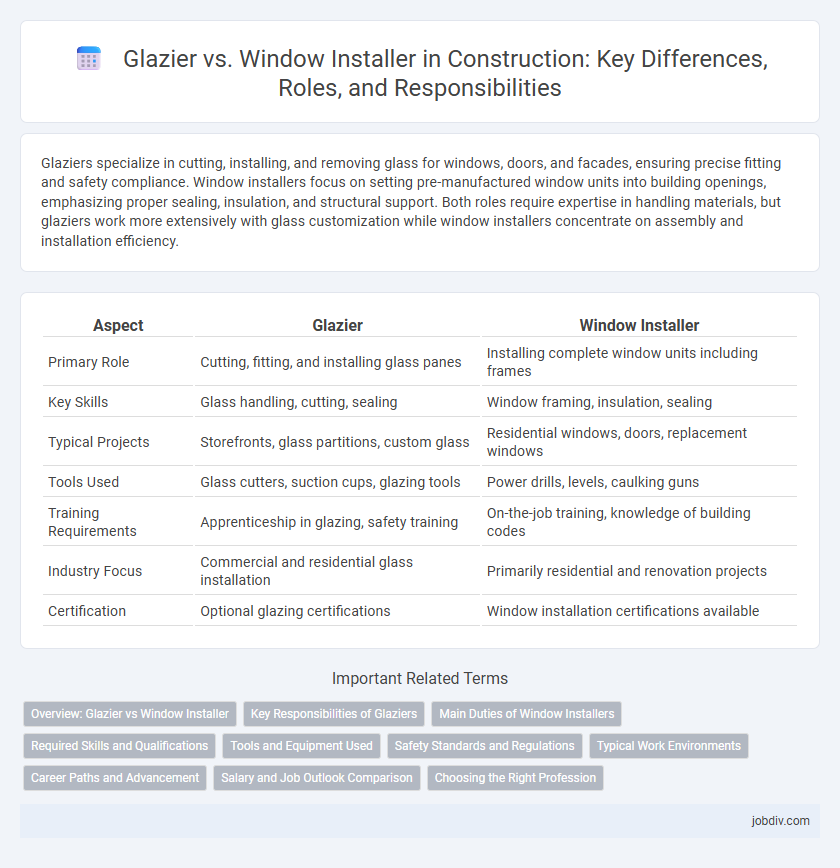Glaziers specialize in cutting, installing, and removing glass for windows, doors, and facades, ensuring precise fitting and safety compliance. Window installers focus on setting pre-manufactured window units into building openings, emphasizing proper sealing, insulation, and structural support. Both roles require expertise in handling materials, but glaziers work more extensively with glass customization while window installers concentrate on assembly and installation efficiency.
Table of Comparison
| Aspect | Glazier | Window Installer |
|---|---|---|
| Primary Role | Cutting, fitting, and installing glass panes | Installing complete window units including frames |
| Key Skills | Glass handling, cutting, sealing | Window framing, insulation, sealing |
| Typical Projects | Storefronts, glass partitions, custom glass | Residential windows, doors, replacement windows |
| Tools Used | Glass cutters, suction cups, glazing tools | Power drills, levels, caulking guns |
| Training Requirements | Apprenticeship in glazing, safety training | On-the-job training, knowledge of building codes |
| Industry Focus | Commercial and residential glass installation | Primarily residential and renovation projects |
| Certification | Optional glazing certifications | Window installation certifications available |
Overview: Glazier vs Window Installer
Glaziers specialize in cutting, installing, and repairing glass for windows, doors, and storefronts, focusing on the precise fitting and finishing of glass materials. Window installers install window units, including frames and sashes, ensuring proper sealing, insulation, and alignment within building structures. Both professions require knowledge of building codes and safety standards, but glaziers emphasize glass craftsmanship while window installers concentrate on the overall assembly and installation of window systems.
Key Responsibilities of Glaziers
Glaziers specialize in cutting, installing, and removing glass for windows, skylights, storefronts, and other glass surfaces in both residential and commercial buildings. Their key responsibilities include measuring and cutting glass to precise dimensions, applying sealants and weatherproofing materials to ensure proper installation, and repairing or replacing damaged glass panels. Unlike window installers, who focus on fitting entire window units, glaziers concentrate specifically on handling and securing glass components within window frames and other structures.
Main Duties of Window Installers
Window installers specialize in measuring, fitting, and securing windows to ensure proper insulation and structural integrity in buildings. They handle the installation of various window types, including vinyl, wood, and aluminum frames, ensuring alignment and weatherproofing. Their work involves sealing gaps with caulk or foam to prevent air and water infiltration, contributing to energy efficiency and building safety.
Required Skills and Qualifications
Glaziers require expertise in cutting, installing, and removing glass in windows, doors, and skylights, emphasizing precision and safety knowledge for handling glass materials. Window installers need proficiency in measuring, fitting, and sealing windows within various structural frameworks, highlighting skills in carpentry and insulation techniques. Both roles demand physical strength, attention to detail, and understanding of building codes and safety standards.
Tools and Equipment Used
Glaziers primarily use specialized cutting tools, glass cutters, suction cups, and glazing knives to measure, cut, and install glass panels with precision. Window installers rely heavily on power drills, levels, shims, and sealants to ensure proper fitting and secure installation of window frames. Both roles require safety gear such as gloves and goggles, but glaziers focus more on handling fragile glass, while window installers emphasize framing and sealing.
Safety Standards and Regulations
Glaziers and window installers must adhere to strict safety standards and regulations, including OSHA guidelines for fall protection, personal protective equipment (PPE), and proper handling of glass materials to prevent injuries. Glaziers typically work with large, heavy glass panels that require specialized training in lifting techniques and safety protocols, while window installers focus on secure fitting and weatherproofing standards to ensure structural integrity and compliance with building codes. Both roles demand rigorous safety training to mitigate risks associated with sharp glass edges, heavy equipment, and elevated work environments.
Typical Work Environments
Glaziers typically work in commercial and residential construction sites, installing glass panels in windows, skylights, and storefronts under variable weather conditions and often at heights requiring safety equipment. Window installers usually operate in more controlled environments such as new or existing homes, focusing on fitting complete window units, seals, and frames to ensure thermal efficiency and weatherproofing. Both roles demand precision and safety awareness, but glaziers face more exposure to outdoor elements and glass handling risks compared to window installers who frequently work indoors or in partially protected spaces.
Career Paths and Advancement
Glaziers specialize in cutting, installing, and removing glass for windows, skylights, and facades, often requiring precise craftsmanship and knowledge of safety standards. Window installers focus on fitting pre-manufactured window units, emphasizing building code compliance and energy efficiency during installation. Career advancement as a glazier may lead to supervisory roles or specializing in custom glass work, whereas window installers can progress to project management or become certified energy auditors within construction firms.
Salary and Job Outlook Comparison
Glaziers earn an average annual salary ranging from $40,000 to $60,000, reflecting their specialized skills in cutting, installing, and removing glass for windows and other structures. Window installers typically make slightly less, with salaries averaging between $35,000 and $55,000, as their role concentrates primarily on fitting and sealing pre-made window units. Job outlook for both positions is positive, with the U.S. Bureau of Labor Statistics projecting employment growth of about 5% for glaziers and 4% for window installers over the next decade, driven by increasing construction and remodeling activities.
Choosing the Right Profession
Glaziers specialize in cutting, installing, and removing glass panels for windows, doors, and skylights, ensuring precise fitting and sealing for optimal durability and safety. Window installers focus on fitting pre-manufactured window units into openings, emphasizing proper alignment, insulation, and weatherproofing to enhance energy efficiency and structural integrity. Selecting the right profession depends on whether the project requires custom glass fabrication and repair (glazier) or efficient window unit installation and replacement (window installer).
Glazier vs Window Installer Infographic

 jobdiv.com
jobdiv.com